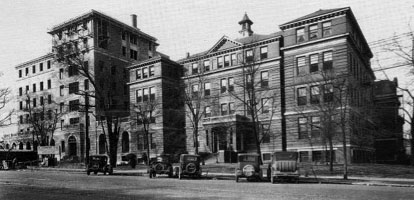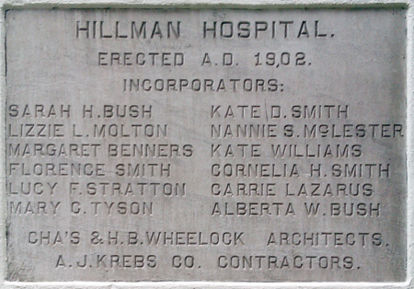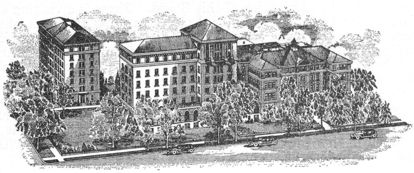Hillman Hospital

Hillman Hospital opened in 1888 on Birmingham's Southside to provide medical care for the poor, regardless of race or gender, and remains as the oldest hospital in the city. It was named for benefactor Thomas Hillman in 1896. The property was sold to Jefferson County in 1907 and it became part of the Medical College of Alabama in 1945. It is now a part of the sprawling UAB Medical Center
The idea of creating a charity hospital began with a group of Protestant, Catholic and Jewish women, the wives of Birmingham business executives, who formed the Daughters of United Charity to raise funds and oversaw its operation as the "Board of Lady Managers". They incorporated their venture as the Hospital of United Charity on March 9, 1887. The 28-bed hospital opened, in rented space in the Hughes Building, on October 23, 1888 and moved more than once over the next few years until a purpose-built 100-bed hospital building was constructed for it in 1890. Unfortunately, that building was destroyed in a fire in 1894.
Soon thereafter, Tennessee Coal, Iron and Railroad Company president Thomas Hillman donated a portfolio of stocks and bond funds valued at $20,000 to the hospital, stipulating that the monies be used equally for white and black patients. The hospital, once again leasing its space, was renamed in his honor in March 1896. Beginning in 1897 Hillman Hospital was rechartered by the state and planning for a new building was begun. A mass meeting was held at First Methodist Church on the evening of February 10, 1901 to raise funds for the new building. The meeting netted $6,162.44 of the $25,000 sought.
In 1901 property on the 600 block of 20th Street South was acquired from John Cox and architects Charles and Harry Wheelock were commissioned to design the building. Ground was broken on May 2, 1902, and the four-story brick and limestone Hillman Hospital which still stands was constructed by A. J. Krebs Co. It was dedicated on July 15, 1903.
Four adult wards, one for children, and 12 private rooms filled the first and second floors with additional private rooms on the upper floors. The third floor also had two private operating rooms and an 80-seat surgical amphitheater. The kitchen was on the fourth floor, along with nurses' rooms, and a dining hall. The Birmingham Medical College, which had agreed to take over staffing of the hospital, constructed its own building next door with classrooms, laboratories and dissection rooms.
Ongoing financial shortages and the need to expand forced the Board of Lady Managers to sell the hospital property to Jefferson County in May 1907. Noted 92-year-old physician Will Mayo visited the hospital in 1911 and took note of its crowded conditions. The first addition to the original hospital was completed in 1913, but did little to alleviate overcrowding as the population of Birmingham continued to increase exponentially. The adjoining Medical College closed in 1915, with its facilities transferring to the University of Alabama, which continued operating the school until its last students graduated. The hospital was treating 4,600 patients per year by 1924.
A New Hillman Building and a nurses' dormitory were dedicated on January 15, 1928. Eleven years later a five-story outpatient clinic was constructed alongside the hospital by the Works Progress Administration. It was dedicated on November 19, 1939. Meanwhile the 16-story, 575-bed Jefferson Tower was built by the county, using a Public Works Administration loan, as a complement to Hillman Hospital in 1940.
On June 4, 1945 Hillman Hospital and the county's Jefferson Hospital were merged into Jefferson-Hillman Hospital and jointly deeded to the University of Alabama for the newly-created Medical College of Alabama. In 1955 the combined facility was officially dubbed University Hospital. As a teaching hospital, Hillman-Jefferson continued to serve indigent patients until the opening of Mercy Hospital in 1972. Since then it has housed the Lister Hill Library, the UAB School of Dentistry and administrative offices.
By 1990 UAB had indicated that it planned to demolish Hillman Hospital as the site for a new entrance to UAB Hospital on 20th Street. The building was included in the "Places in Peril" list released by the Alabama Preservation Alliance and the Alabama Historical Commission that year.
Legacy
Obstetrician Thomas Boulware performed many new treatments at Hillman which were "firsts" for Alabama, including the state's first pregnancy test in 1929 and the first "bikini" Caesarean in 1932. He also oversaw the state's first OB/GYN residency in 1934 and opened the county's first indigent maternity clinic at Hillman in 1935.
Hillman Hospital's second, fourth and fifth floors were occupied in the late 1930s and 1940s by the Spies Nutrition Clinic, at which physician Tom Spies conducted research and developed an effective treatment for pellagra and also studied other effects of malnutrition. Though housed at Hillman, the clinic was not operated by the Medical College of Alabama and Spies was not a member of the faculty.
As the city's first hospital open to all races, Hillman fulfilled a crucial role in treating African Americans. Ku Klux Klan victim Judge Aaron was treated at Hillman in 1957, as were many of the victims of the 1963 bombing of 16th Street Baptist Church.
References
- "Over $6,000 for Hillman Hospital" (February 14, 1901) Marion County News
- Bethea, Helen (1928) The Hillman Hospital: A Story of the Growth and Development of the First Hospital in Birmingham, 1888-1907. Birmingham: Board of Managers of Hillman Hospital
- Holley, Howard L. & Eugenia Blount Dabney (January 1961) "History of the Hillman Hospital, Part I: The Hospital of the United Charities." De Historia Medicinae. No. 5, pp. 9-16
- Holmes, Jack D. L. (1974) A History of the University of Alabama Hospitals. Birmingham: University Hospital Auxiliary
- Satterfield, Carolyn Green (1976) "Historic Sites of Jefferson County, Alabama" Jefferson County Historical Commission
- Pennycuff, T. L. (October 31, 2012) "Hillman Hospital" Encyclopedia of Alabama - accessed January 27, 2014
- Wright, A. J. (October 4, 2013) "Hillman Hospital & How It Became UAB Hospital" Birmingham Then & Now. Discover Birmingham - accessed January 27, 2014


